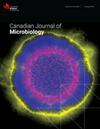拮抗豌豆根腐病病原体 Aphanomyces euteiches 的三种细菌分离物的基因组特征
IF 1.8
4区 生物学
Q4 BIOTECHNOLOGY & APPLIED MICROBIOLOGY
引用次数: 0
摘要
生活在土壤和根际或植物内部的微生物可以促进植物的生长和健康。有益微生物的基因组特征可以揭示它们的特殊特征。通过在加拿大萨斯喀彻温省进行广泛的实地调查,随后进行体外和温室鉴定,我们鉴定出了几种对豌豆根腐病病原菌具有拮抗作用的细菌分离株。本研究对3株分离株假单胞菌sp. rhizo 66 (PD-S66)、synxantha Pseudomonas rhizo 25 (Ps-S25)和Serratia sp. root 2 (TS-R2)进行了基因组测序、组装和注释。PD-S66基因组大小为6 279 416 bp,内含65个contigs, GC含量为59.32%,预测编码序列(CDS)为5653条。Ps-S25基因组大小为6 058 437 bp,共66个contigs, GC含量为60.08%,预测CDS为5575。TS-R2基因组大小为5 282 152 bp,包含26个contigs, GC含量为56.17%,预测CDS为4956。通过数字DNA-DNA杂交(dDDH)和平均核苷酸同源性(ANI)鉴定,PD-S66和TS-R2分别属于假单胞菌属和沙雷氏菌属,Ps-S25属于synxantha假单胞菌属。利用antiSMASH预测生物合成基因簇。基因组数据提供了遗传学和生物化学途径支持这些分离物的拮抗活性。本文章由计算机程序翻译,如有差异,请以英文原文为准。
Genomic characterization of three bacterial isolates antagonistic to the pea root rot pathogen Aphanomyces euteiches
Microorganisms living in soil and rhizosphere or inside plants can promote plant growth and health. Genomic characterization of beneficial microbes could shed light on their special features. Through extensive field survey across Saskatchewan, Canada, followed by in vitro and greenhouse characterization, we identified several bacterial isolates antagonistic to pea root rot pathogen Aphanomyces euteiches. In this study, the genomes of three isolates— Pseudomonas sp. rhizo 66 (PD-S66), Pseudomonas synxantha rhizo 25 (Ps-S25), and Serratia sp. root 2 (TS-R2)—were sequenced, assembled, and annotated. Genome size of PD-S66 was 6 279 416 bp with 65 contigs, 59.32% GC content, and 5653 predicted coding sequences (CDS). Genome size of Ps-S25 was 6 058 437 bp with 66 contigs, a GC content of 60.08%, and 5575 predicted CDS. The genome size of TS-R2 was 5 282 152 bp, containing 26 contigs, a GC content of 56.17%, and 4956 predicted CDS. For the identification of the isolates, digital DNA–DNA hybridization (dDDH) and average nucleotide identity (ANI) values were determined, which confirmed PD-S66 and TS-R2 as potential new species, belonging to Pseudomonas and Serratia genera, respectively, while Ps-S25 belongs to species Pseudomonas synxantha. Biosynthetic gene clusters were predicted using antiSMASH. The genomic data provided insight into the genetics and biochemical pathways supporting the antagonistic activity against A. euteiches of these isolates.
求助全文
通过发布文献求助,成功后即可免费获取论文全文。
去求助
来源期刊
CiteScore
4.80
自引率
0.00%
发文量
71
审稿时长
2.5 months
期刊介绍:
Published since 1954, the Canadian Journal of Microbiology is a monthly journal that contains new research in the field of microbiology, including applied microbiology and biotechnology; microbial structure and function; fungi and other eucaryotic protists; infection and immunity; microbial ecology; physiology, metabolism and enzymology; and virology, genetics, and molecular biology. It also publishes review articles and notes on an occasional basis, contributed by recognized scientists worldwide.

 求助内容:
求助内容: 应助结果提醒方式:
应助结果提醒方式:


